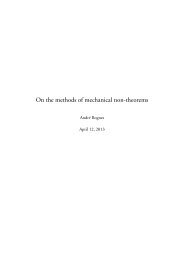The Additivity Theorem in K
The Additivity Theorem in K
The Additivity Theorem in K
Create successful ePaper yourself
Turn your PDF publications into a flip-book with our unique Google optimized e-Paper software.
186<br />
Apply<strong>in</strong>g the above observation and Lemma 2.2 we see that<br />
SimpðgÞ SimpðpÞ<br />
SimpðfÞ=ðn; yÞ ƒƒƒƒƒƒƒƒƒƒƒƒƒƒ!<br />
is a homotopy equivalence.<br />
Now apply <strong>The</strong>orem A^ to the functor<br />
SimpðTÞ<br />
½Simp(f);Simp(g) Š<br />
SimpðXÞ ƒƒƒƒƒƒƒƒƒƒƒƒƒƒ! SimpðYÞ SimpðTÞ<br />
to conclude that ½SimpðfÞ; SimpðgÞŠ is a homotopy equivalence.<br />
F<strong>in</strong>ally, from lemma 2.2 and the natural isomorphism SimpðY TÞ ffi<br />
SimpðYÞ SimpðTÞ we see that ðf; gÞ is a homotopy equivalence. h<br />
With the prelim<strong>in</strong>aries done, we now prove the additivity theorem us<strong>in</strong>g<br />
<strong>The</strong>orem A ^ , thus convert<strong>in</strong>g the proof to a <strong>The</strong>orem A style proof.<br />
Let C be a category with cofibrations and weak equivalences [7, 1.2], E be<br />
the category of cofibration sequences of C, and ? be a chosen <strong>in</strong>itial and f<strong>in</strong>al<br />
object of C. We use the notation S:C for Waldhausen’s S-construction and<br />
S:C for the associated simplicial category with cofibrations and weak equivalences<br />
[7, 1.3]. We will use wSnC to denote the category of weak equivalences<br />
of SnC and likewise for wSnE.<br />
THEOREM 2.3. [<strong>Additivity</strong> <strong>The</strong>orem (7, <strong>The</strong>orem 1.4.2)]. <strong>The</strong> map<br />
wS:E ! s;q wS:C wS:C that sends the cofibration sequence ðA C BÞ to<br />
ðA; BÞ is a homotopy equivalence.<br />
Waldhausen deduces this theorem from the follow<strong>in</strong>g lemma.<br />
LEMMA 2.4. [7, Lemma 1.4.3] <strong>The</strong> map S:E ! s;q S:C S:C of simplicial sets<br />
is a homotopy equivalence.<br />
Proof. In order to apply <strong>The</strong>orem A ^ , we will need to verify that for all n <strong>in</strong><br />
N and for all A0 <strong>in</strong> SnC the map s=ðn; A0Þ! qp S:C is a homotopy equivalence.<br />
However, <strong>in</strong> Waldhausen’s proof of the Sublemma to Lemma 1.4.3 <strong>in</strong> [7, 1.4]<br />
he shows that qp has a simplicial homotopy <strong>in</strong>verse. One needs to observe<br />
only that the map he calls p is our qp and the map he calls f is our s. h<br />
3. Convert<strong>in</strong>g A Simplicial Proof<br />
KEVIN CHARLES JONES ET AL.<br />
In this section, we show how to convert the proof of the additivity theorem<br />
found <strong>in</strong> [3] to a <strong>The</strong>orem A style proof. We beg<strong>in</strong> by review<strong>in</strong>g the naive<br />
homotopy fibers <strong>in</strong>troduced <strong>in</strong> [1].<br />
Let T be a simplicial set, and suppose t 0 2 Tp and t 2 Tq. <strong>The</strong> notation<br />
u: t 0 V t means u 2 Tpþqþ1 and ui ¼ t 0 and uj ¼ t, where i is the map <strong>in</strong>duced<br />
by the order-preserv<strong>in</strong>g map ½pŠ !½p þ q þ 1Š which sends ½pŠ onto the first<br />
p þ 1 elements of ½p þ q þ 1Š and j is the map <strong>in</strong>duced by the map

















